古建新衣
——欧洲城市如何通过创新性建筑系统翻新实现改变New Skin – Old Building: How European Cities are Changing そrough Innovative Retro fi t Building Systems
西尔维娅·贾梅塔/Silvia Giammetta尚晋 译/Translated by SHANG Jin
古建新衣
——欧洲城市如何通过创新性建筑系统翻新实现改变New Skin – Old Building: How European Cities are Changing そrough Innovative Retro fi t Building Systems
西尔维娅·贾梅塔/Silvia Giammetta尚晋 译/Translated by SHANG Jin
在过去的10年中,欧洲关于战后建筑节能改造的设计讨论在城市的再生过程中具有重要意义。事实上,低能效是影响城市和郊区大部分建筑的一个严重问题,并已成为学者和技术人员科学研究的对象以及建筑构件制造商的一大业务。无论是伯纳德·鲁道夫斯基所谓的“非正统”还是“正统”建筑,这都是一个重要问题。对于“非正统”建筑来说,这些新技术也有助于从定性的角度推动城市空间再生,将平凡的老建筑改造得更具吸引力、更加丰富多彩。这就是建筑师在需要干预大师杰作时的责任:一般来说,这些建筑承载着它们时代的形式特征以及创造它们的文化社会语境的内在价值。改变它的外观就意味着改变一种难以挽回的记忆:因此本文将展示在对普通建筑立面进行翻新美化的同时,为何会出现深入的建造史研究。除了深入对20世纪大师之作的具体知识之外,本文还有重新审视某些理性主义或野兽派杰作的目的。从文化和建筑场地实践的角度看,一些极为精细的工作最近出现在弗朗兹编纂的《20世纪建筑的建筑环境与宜居室内:认识问题和制定保护策略》中并非巧合:记忆的知识作为建筑与城市遗产再生的一种工具无疑是一条特殊的原则。在未来的数年中,它会在法律的强制性之外、或者通过巧妙利用某种商业产品,对建筑师干预“正统”与“非正统”建筑的设计原则和从业道德予以指导。(A.B.)
欧洲城市正在经历一个变化的新纪元。与1950-1980年代的住房激增相比,我们现在看到的变化要小得多,但这仍代表了这些年的各种现象。尤其是关于可持续性的环境问题与房地产危机和化石燃料危机的加剧,使人们对翻新的关注与日俱增。
事实上,大部分20世纪建成的欧洲建筑今天都需要翻新。欧洲建筑的存量高达240亿m2,分布在近4500万km2的土地上,其中居住着5.01亿人。根据欧洲建筑性能研究院(BPIE)在2011年进行的研究[1],全欧洲65%的建筑面积集中在德国、法国、英国、意大利和西班牙。尽管如此,这些国家的建筑大多是在最早的节能法律颁布之前建成的。事实上,根据Eurostat的估算,欧洲能耗总量的40%来自建筑,即欧洲碳排放的1/3。到2050年实现欧盟制定的节能目标,就意味着要以年均3%的速率对低能效建筑进行改造。
欧洲建筑不只是能效低,而且难以满足舒适度、声效、健康和无障碍等方面的实际需求。翻新能通过达到新建筑的定量标准延长现存建筑的生命周期。审美与空间需求自1950年代以来也一直在变化,同时新的需求取代并超越了旧的需求。结果就需要越来越整体性的方法来分析和解决城市与建筑的问题。
此外,建筑翻新给欧洲建筑行业整体带来了一个复兴的机会。事实上,由于房地产危机的影响,对新建筑的投资从2008年起就一直在减少,而进行翻新的建筑在不断增加[2]。
为了促进建筑翻新市场的发展,就需要有针对性的政策及为这一应用领域专门开发和测试的先进技术。由此一来,许多欧洲项目应运而生(例:ECBCS IEA Annex 50, IEE Renew School, TES Energy Façade, e803Gebäude, Energiesprong,REHA, Holzbau der Zukunft, BERTIM),开发以轻型预制木模块为基础的创新性过程和系统。
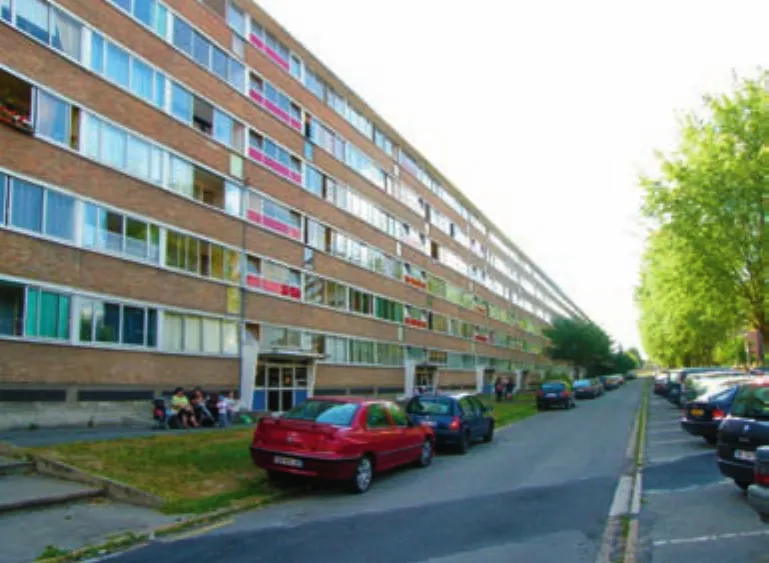
1a 翻新前的建筑/The building before the retro fi t
尽管每个项目都源自不同的背景,但在过程上都有一些共同点。这是利用轻型预制模块进行的翻新所特有的,并且在诸多方面都比传统的翻新都更具挑战性。从初步方案到预制构件生产的各个阶段都要比传统的翻新更加精确、耗时,而这些时间将会在装配阶段得到弥补。TES节能立面项目表明,进行这种翻新所需的总时间最终要比传统翻新少大约20%[3]。
在节能之外,这些系统使整体性方法的应用和对整个过程进行全面的控制成为可能。这将保证建筑的品质,并节约时间和成本。
从技术问题出发,在上述项目框架中实施的很多案例都带来了城市的更新,并提高了房地产的价值。例如,法国的REHA项目(集体住宅高能效再评价)是由PUCA开展的政府项目。项目于2007年启动,并与法国主要的政府和私人住宅供应商合作。其目标是为1960-1980年代建成的集体住宅的翻新进行技术、社会和经济方面的创新和检验,使之达到新建筑的性能水平,并给建筑的拆除提供有效的替代方案。但这些目标不只在技术性能上:建筑和使用质量、城市品质和人居环境的多样化也是它的目标。该项目通过号召对公共建筑的翻新,促进了技术创新和对创新性过程的探索。这一号召让参与方按多学科专长以及不同的专业人士成立工作组,以制定解决城市环境各方面问题的整体性方法。其结果是一举多得的翻新方案:生活空间经扩展达到了当代社会的需求,新的围护结构中加入了楼梯以控制热损失,增加的电梯保证了无障碍交通,并更新了形式语言。例如,在夏尔·勒纳尔工作室的图尔宽欧几里得大楼的翻新方案中,建筑的一部分被拆除,以带来更好的城市通透性。这座

1b 翻新过程中:现有的围护结构被拆除,并替换一新/During the retro fi t: the existing envelope is demolished and replaced by the new one.
Memory and Regeneration
Column Editors: Alberto Bologna, Michele Bonino,Pierre-Alain Croset
In the last decade, in Europe, the design topic of the energy adaptation of buildings built in the post-war period is really of great relevance within urban regeneration processes. Energy inefficiency is, in fact, a serious problem affecting most of the buildings that make up cities and suburbs and has become both the object of scientific studies of scholars and technicians and, as a result, a large commercial business by manufacturers of building components. This is a problem that characterises both "non-pedigreed" and "pedigreed" architectures,to use a definition so dear to Bernard Rudofsky.If, in the case of "non-pedigreed" architectures,these new technologies also help to regenerate the urban space from a qualitative point of view by transforming old and anonymous buildings into more attractive ones, more complex becomes the role of the architect when called upon to intervene on Masters' architectures: normally, these are buildings that carry with them as well as formalism of their time also values intrinsic to the cultural and social contexts in which they were born.Changing its appearance would mean altering a memory hardly to reconstruct: so here is how, in parallel with the operations of maquillage aimed at refurbishing mainly the facades of ordinary buildings are also born sophisticated construction history studies that, in addition to contributing to the material knowledge of certain works by the Masters of the 20th Century, are aimed at requalifying some masterpieces of rationalism or brutalism. It is no coincidence that some examples of these extremely refined operations both from a cultural point of view as well as from the practice of the building site have recently found space in the volume edited by Franz Graf and Giulia Marino Building Environment and Interior Comfort in 20th Century architecture: Understanding Issues and Developing Conservation Strategies (Lausanne:PPUR, 2016): the knowledge of the memory as a tool for regenerating architectural and urban heritage is certainly a principle that, in the years to come, it should guide the design principles, as well as the consciences, of architects called upon to intervene both on "pedigreed" and "non-pedigreed"architectures, beyond the legislative imposition or by the convenience of the use of a certain commercial product. (A.B.)
European cities are going through a new era of changes. Compared to the housing boom which characterised the years between the 1950s and the 1980s, we are now witnessing much smaller transformations, but still very representative of the reflections carried out during these years. In particular, the rise of environmental considerations on sustainability combined to the real estate crisis and to the fossil fuel crisis, led to a growing interest in retro fi tting.
Actually, most of the European buildings realised during the twentieth century is now in need of a retro fi t.The European building stock covers 24 billion m2on a land area of nearly 4.5 million km2for a population of 501 million inhabitants. According to a research[1]carried out by BPIE in 2011, 65% of the whole European floor space is gathered in Germany, France, United Kingdom, Italy and Spain. Though, the building stock of these countries was mainly built before the fi rst laws on energy performances. In fact, according to Eurostat estimates, around 40% of the total amount of the European energy consumption is due to its building stock, which is also responsible for one third of the European CO2emissions. Meeting the energetic goals set by the EU by 2050 means to improve the ineきcient building stock at a rate of 3% per year.230m长的建筑原有168间公寓,现在被分为有30间和72间公寓的两座建筑,并增加了一个新的广场。虽然少了66间公寓,但实现了更高的生活和城市品质。其中最小的那座建筑的短边全部进行了重新设计,并将无窗的立面改造得错落有致,从而成为该区入口优美的展示空间。对这座建筑的扩建增加了130m2的建筑面积。原来冗长而重复的标准立面被改造为最新式的,其设计满足了各方面需求。
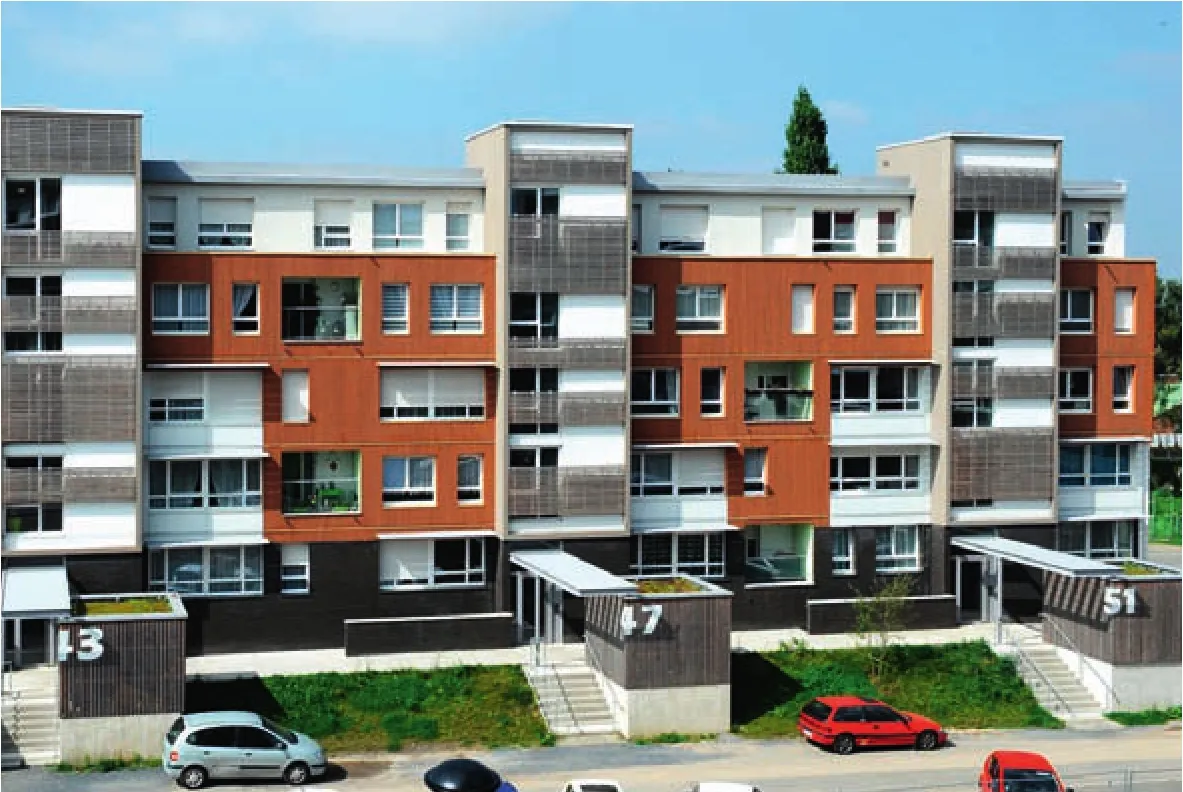
1c 翻新后的建筑/The retro fi tted building
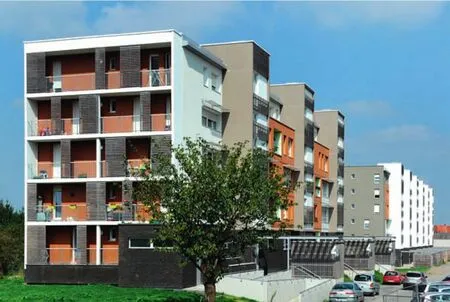
1d 原来无窗的立面被改为新的阳台/The new terraces where there once was a blind façade
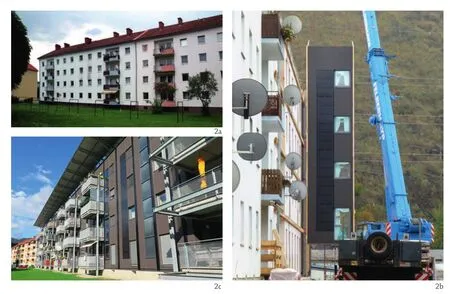
2 e803大楼项目,约翰·伯姆大街,卡普芬贝格,奥地利/e803 Gebäude Program, Johann Böhm Straße, Kapfenberg, Austria(照片版权/Photo Credits: AEE Intec)
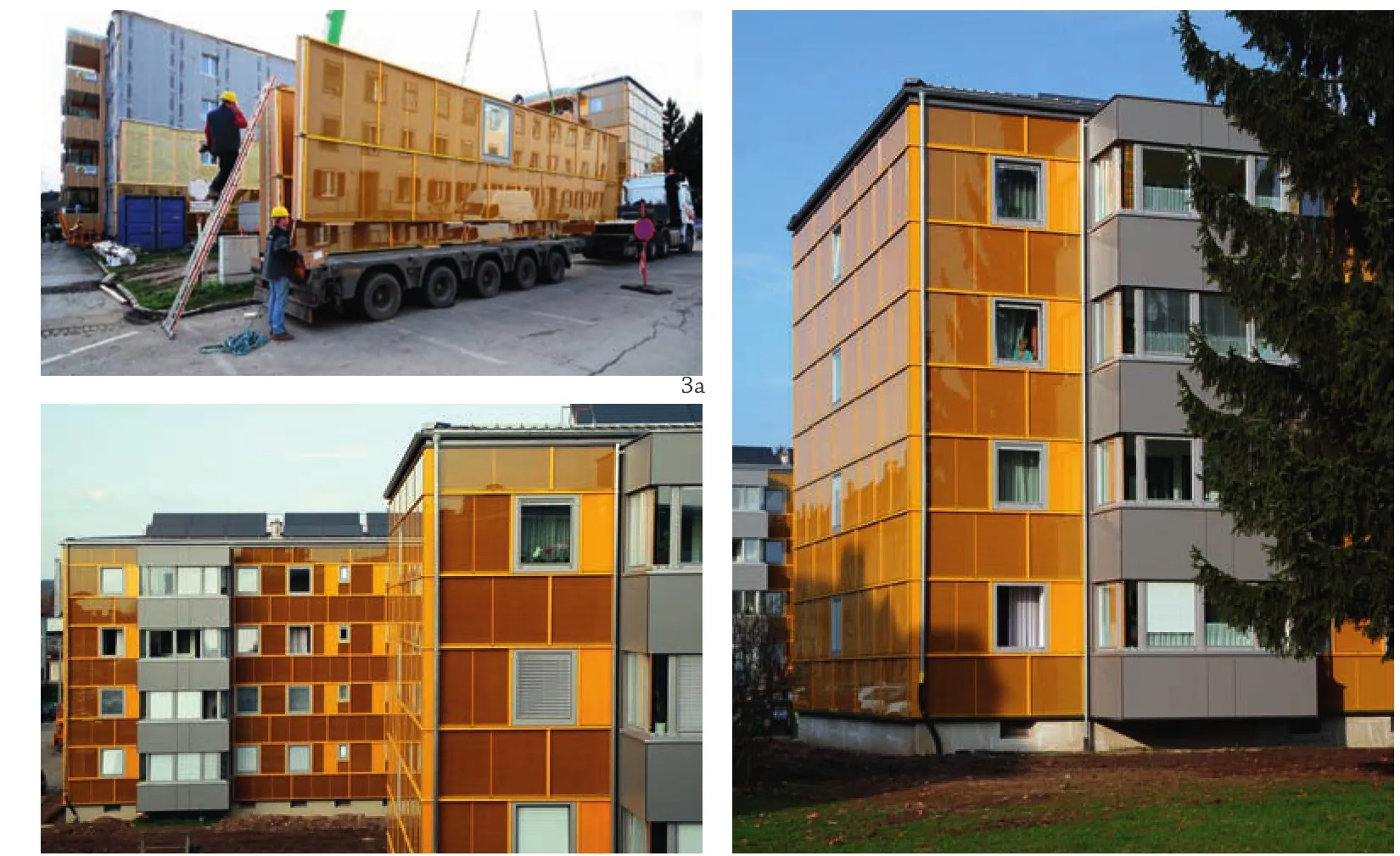
3 Annex 50项目,狄塞耳韦格,格拉茨,奥地利/Annex 50,Dieselweg, Graz, Austria(照片版权:GAP方案有限公司/Photo Credits: GAP Solutions GmbH)
创造新城市品质的另一个翻新实例是奥地利项目e803大楼。这是“未来城市”技术性研究项目的一部分,其中包含专门用于“未来住宅”的特殊类型。该项目自2013年以来一直在实施,其目标是为城市环境的环境与能源可持续性研究新的技术系统并加以实施。该项目由AEE Intec(可持续技术研究院)实施,目标是对1950-1980年代用预制系统建成的多户住宅进行翻新。该系统将以主动和被动方式来实现能源的独立。藉此设计了三类模块:一种基本的、一种结合了太阳能板的主动式的,还有一种HVACR模块的。在奥地利卡普芬贝格的约翰·伯姆大街进行的翻新结果令人印象深刻:不仅能效得到了提高,而且建筑焕然一新。事实上,太阳能板一部分与建筑表皮融为一体,另一部分构成了新增阳台的遮阳板。新的生活空间使住户获益,而翻新彻底改变了建筑与环境的关系,成为不分彼此的一体。
在Annex 50项目的框架中,创新性的GAP墙板被用到格拉茨Dieselweg(A)的案例中。在这个例子中,一座由204间公寓组成的住宅楼群被整体翻新。这些建筑是1950、1960年代建成的,保温很差,冷桥很多。这次翻新提高了保温性能,并让建筑群焕然一新。
这些翻新立面不只是提高建筑能效的技术方案,还给建筑带来了又一次机会。这是通过改造规整、甚至是重复性的立面给城市环境带来复杂性和多样性的机会。那些立面体现着1950-1980年代欧洲各地建造的预制混凝土建筑的典型特征。这是提升城市环境认同和居民归属感的机会。我们机不可失!□
/References
[1] B. Atanasiu et all. Europe's Buildings under the Microscope. A Country-by-country Review of the Energy Performance of Buildings, Buildings Performance Institute Europe (BPIE). 2011: 27-28.
[2] 80th Conference EUROCONSTRUCT-CRESME.Budapest, December 2015.
[3] M. Teibinger, F. Lattke. "Modernisierung mit vorgefertigten Holzelementen", att. Zuschnitt –Thermische Sanierung und Modernisierung von Bestandsgebäuden. proHolz Austria, 2013: 2-5.
The European building stock is not only energetically inefficient, but also inadequate to actual requirements with regard to comfort,acoustics, health and accessibility. Retrofitting allows to extend the life cycle of an existing building by meeting the qualitative standards of new ones.
Aesthetical and spatial requirements have been changing too since the 1950s and new necessities go over and above old ones. As a result, a more and more holistic approach is necessary to analyse and solve urban and building issues.
Moreover, retrofit of the building stock is a recovering opportunity for the European building sector as a whole. In fact, investments on new buildings have been decreasing since 2008 due to the real estate crisis, while the ones in retro fi t have been raising[2].
In order to strengthen the retrofit market,targeted policies and cutting-edge technologies specifically developed and tested for this field of application are necessary. For this purpose,some European programmes (ECBCS IEA Annex 50, IEE Renew School, TES Energy Façade, e803Gebäude, Energiesprong, REHA, Holzbau der Zukunft, BERTIM) were born to develop innovative processes and systems based on timber lightweight prefabricated modules.
Even though every programme originates from different backgrounds, they all share some points in the process, which is peculiar for retro fi ts with light prefabricated modules and much more challenging than traditional refurbishment from many points of view. The phases from the preliminary draft to the production of the prefabricated elements have to be much more accurate and precise than in a traditional refurbishment, though this time will be recovered in the assembly phase. The TES Energy Façade programme reveals that, in the end, the total amount of time needed to carry out this kind of retrofit is around 20% less than in traditional refurbishments[3].
In addition to energy savings, these systems offer the possibility to apply a holistic approach and to have a complete control over the whole process, which guarantees quality and savings in time and costs.
Starting from technical issues, many of the case studies carried out in the framework of the programmes mentioned above produced an urban regeneration that enhanced the value of the real estate assets. The French REHA programme (Requalification à haute performance énergétique de l'habitat collectif), for example, is a governmental programme by PUCA, founded in 2007 and undertaken in partnership with major French public and private housing providers. The aim of the project is the development and testing of technical, social and economic innovations for retrofitting collective usage buildings built from the 1960s to the 1980s so that they can achieve the performance levels of new buildings, in order to give a strong alternative to demolition. But the goals are not only technical performances but also include architectural and usage qualities, urban qualities and diversifying the habitat are the other targets.The programme promotes technological innovation and experimentation of innovative processes through calls for retrofitting public buildings. The calls ask participants to build working groups based on multidisciplinary competences and different professionals in order to promote a holistic approach to the issues of the urban environment.The results are retrofit actions which tackle more issues at once: living spaces are expanded to meet the requirements of contemporary society,staircases are incorporated into the new envelope in order to tackle heat losses, lifts are added in order to guarantee accessibility and the formal language is updated. In the case of the retro fi t action designed by Atelier Charles Renard on the Euclide building in Tourcoing, for example, part of the building was demolished in order to achieve more urban permeability. The 230 metres long building, housing 168 apartments, was split into two buildings of 30 and 72 apartments and a new square was realised.66 apartments were lost, but a higher living and urban quality was achieved. The short side of the smallest building was completely redesigned and transformed from a blind facade to a terraced one,becoming a beautiful showcase at the entrance of the district. In the same building, extensions were introduced which allow to enlarge by 130m² the fl oor space. A long, repetitive, standard facade was transformed into an up-to-date building, designed to meet various requirements.
Another example of retro fi t programme which created a new urban quality is the one carried out by the Austrian programme e803Gebäude. This is part of the programme for technological research Stadt der Zukunft, which has a specific category dedicated to the Haus der Zukunft (the house of the future). The programme has been running since 2013 and aims at studying and realising new technological systems for the environmental and energy sustainability of the urban environment.The e803Gebäude programme was carried out by AEE Intec (Institut für Nachhaltige Technologien)and the aim was retro fi tting multifamiliar buildings built between the 1950s and the 1980s by realising a prefabricated system which works in active and passive ways in order to reach energy independence.Three types of modules were designed: a basic one, an active one incorporating solar panels and a HVACR module. The result of the retrofit action carried out at the Johann Böhm Straße in Kapfenberg (A) is impressive: the energy eきciency was improved and the building got a new appeal.In fact, solar panels are in part incorporated in the building skin and in part build a new shading sail which covers newly added balconies. The inhabitants benefit from new living spaces and the retrofit action completely changed the relationship between the building and the environment which now seeps through the building and becomes part of it.
In the framework of the Annex 50 programme,the innovative GAP solutions panels were applied to the case study in Dieselweg, Graz (A). In this case an entire housing complex composed by 204 apartments was retrofitted. The buildings had been realised between the 1950s and the 1960s and had poor insulation, presenting many thermal bridges. The retrofit allowed to improve thermal performances and gave a new shine to the buildings.
These retrofit façades aren't only technical solutions to enhance energy performances of buildings, they represent a second chance for architecture. It's the chance to bring complexity and variety to the urban environment by transforming the regular and almost repetitive façades which are typical for the prefabricated concrete buildings realised all around Europe between the 1950s and the 1980s. It's the chance to work on the identity of the urban environment and on the sense of belonging of the people who live in it. We shall not miss this chance.□
记忆与再生
栏目主持:阿尔韦托·博洛尼亚,米凯利·博尼诺,皮埃尔-阿兰·克罗塞特
都灵理工大学
2017-10-13
- 世界建筑的其它文章
- Designing the Exhibition Space for "The New Normal", Beijing, China, 2017
- 传统文化与地景建筑的结合
——上海顾村规划展示馆设计TheCombination of Traditional Culture and Landscape Architecture: The Design of Shanghai Gucun Planning Exhibition Hall - “例外状态”展览空间设计,北京,中国
- 简讯
- 门
——随感一篇Doorway: A そought Piece - 通往异乡之门The Gate to the Alien World

